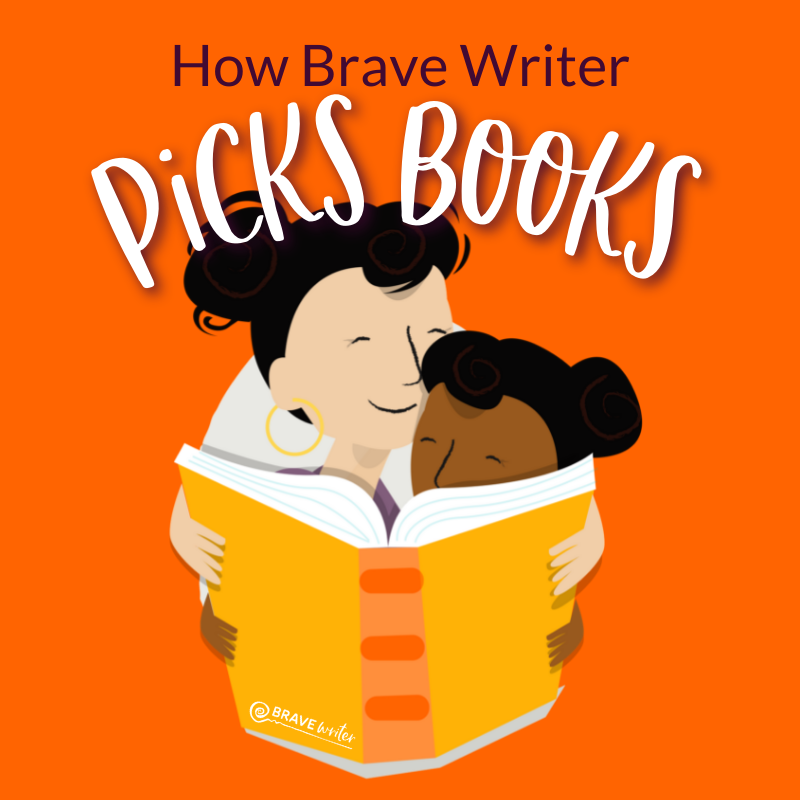How Brave Writer Picks Books

How many books do you think Dawn, our Director of Publishing, had to read to select the books featured in our Mechanics & Literature programs? I’ll wait…
Did you guess 40? 55? 70? In fact, she read over 100.
The jigsaw puzzle of selecting books is no small feat! What follows is Dawn’s outline of how we go about putting together a year of reading with your family that leads to rich learning and family closeness. Can’t wait to share our brand new book lists with you!
What’s the process of pulling the book lists together?
- Customers recommend books or topics
- Staff members suggest books
- We follow publishers to keep up with what’s new
- We keep tabs on new and popular books on GoodReads and other book-related sites
Those recommendations go into a project and we read throughout the year—yes, we are already reading for the 2022–2023 lists!
There’s no guarantee that a book we love will even make a list. There are lots of moving parts once we start putting the books into a sequence and stand them up side-by-side. For instance, we don’t want a string of depressing story-lines or too many books in a row that feature animals as the protagonists.
As the year progresses, we look for what’s missing—holes—in the lists. We want to ensure a year of reading that feels fresh each month, not a retread of what has already been experienced.
We also keep in mind the books we feature in our Literature Singles—books from previous years. The trick is to find the magic TEN that will make a list (FIVE, for the Slingshot).
What does a book need to make the cut?
- Amazing writing is the first hurdle for a book. That’s not to say that every book on our list has the most stellar writing—sometimes a book’s popularity with kids lands it a spot which allows us to showcase mechanics in a book your kids already enjoy.
- We look for an engaging plot or slice of life. A rip-roaring plot can pull readers along and keep them engaged, but sometimes it’s nice to slow down and appreciate the quiet moments in life. Bronze and Sunflower comes to mind—there’s a plot, of course, but the amazing aspect of that book is the level of daily life details, and, of course, the writing. It knocked our socks off!
- The book needs to be appropriate for the developmental level. A book might bump up to a Boomerang or down to an Arrow or Dart depending on the themes or the vocabulary.
- We always look for party possibilities, of course! (*wink*). Some books just scream “Party with me!” (we’re looking at you, PIE!), while other books deal with heavier topics that don’t lend themselves to a “party” atmosphere. You may have noticed that some issues refer to the book club as a “gathering” rather than a “party.” It’s a slight shift, but a good distinction to make when considering the celebration of books with heavier topics.
What are our considerations?
- Library of variety. Our goal in putting together our book lists is to provide a “library of variety” in two ways: genre and representation. In terms of genre, we include historical fiction, graphic novels, fantasy, poetry, and modern fiction to name a few. In terms of representation, we look for characters and authors from a wide variety of backgrounds. We are particularly attuned to the trend in publishing called Own Voices books—meaning the author is a member of the community that is the focus of the book.
- Filling gaps in our overall Literature Singles list. In the fall of 2019, Dawn attended an Equity in Action course for librarians. The goal of the course was to learn how to audit a collection of books by surveying the standing collection and looking for gaps in representation. Our audit helped us make selections that fill those gaps. It’s a satisfying process, even if it’s a long and ongoing one here at Brave Writer.
- Finding windows and mirrors. You may have heard that books can be both windows and mirrors. The phrase “mirrors and windows” was first introduced by Emily Style for the National SEED Project. A mirror is a story that reflects your own culture and helps you build your identity. A window is a resource that offers you a view into someone else’s experience. Rudine Sims Bishop expanded on these concepts with the addition of sliding glass doors that allow readers to walk into a story. Then Grant Snider, a comic artist, expanded it even further: stepping stones, overcoats, anchors, springboards, escape hatches, quiet corners, warm blankets, flying carpets, and beacons for new readers.
We are so excited to introduce you and your kids to great literature! Read along with us this year by purchasing a year-long program: Quill, Dart, Arrow, Boomerang, or Slingshot!


















